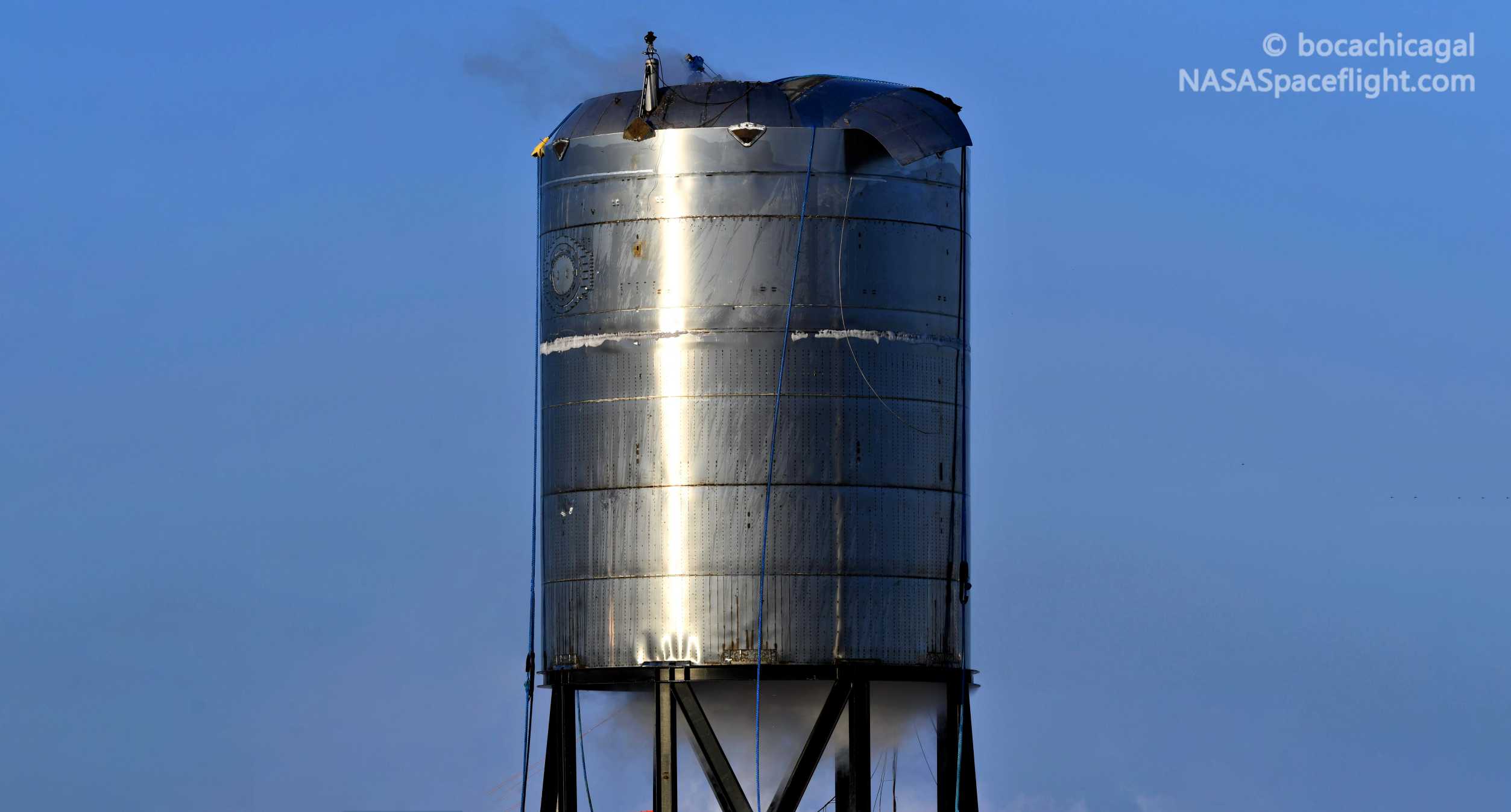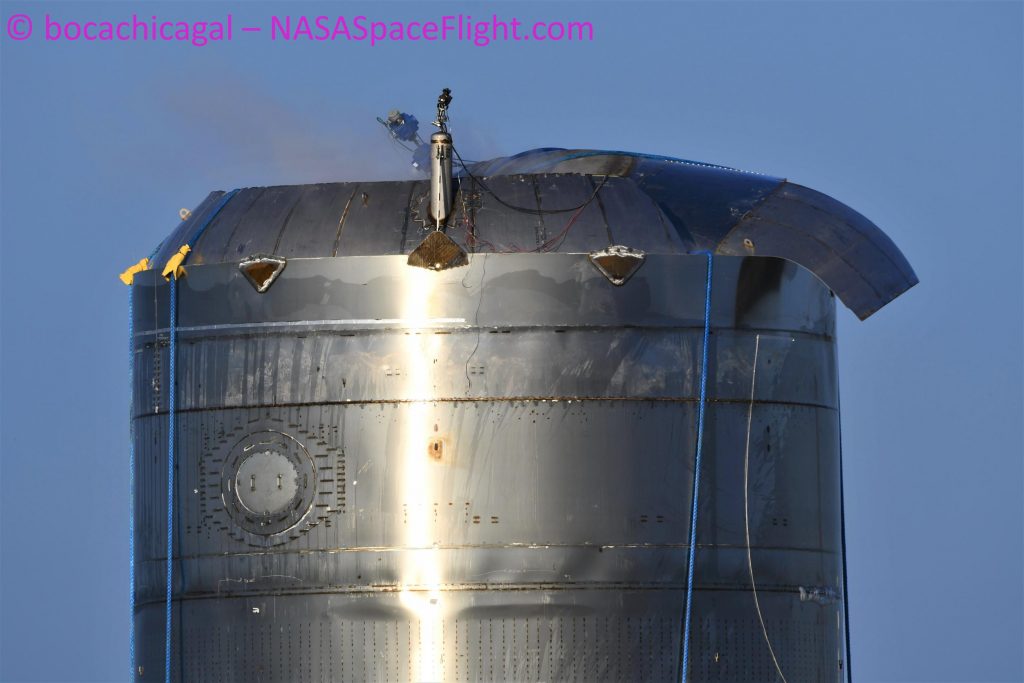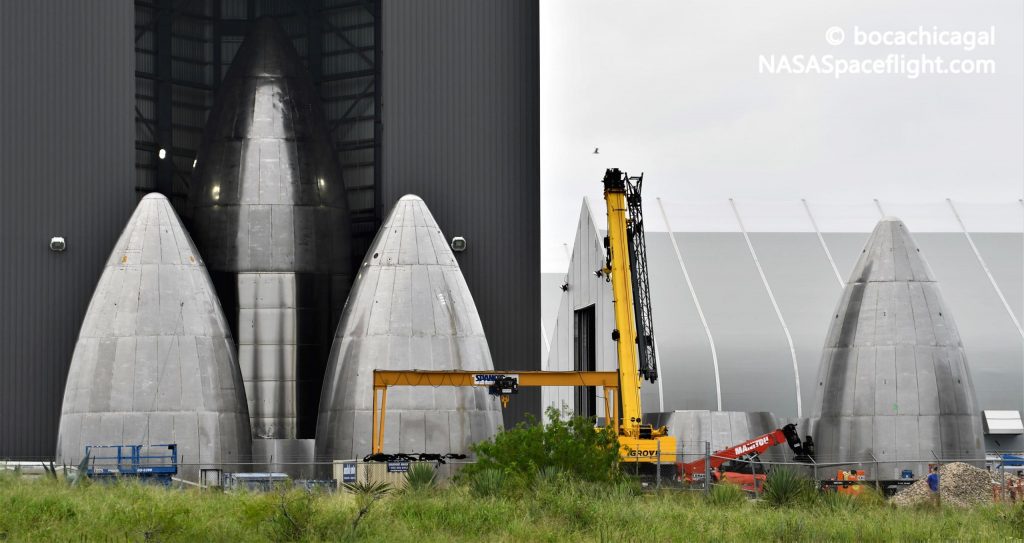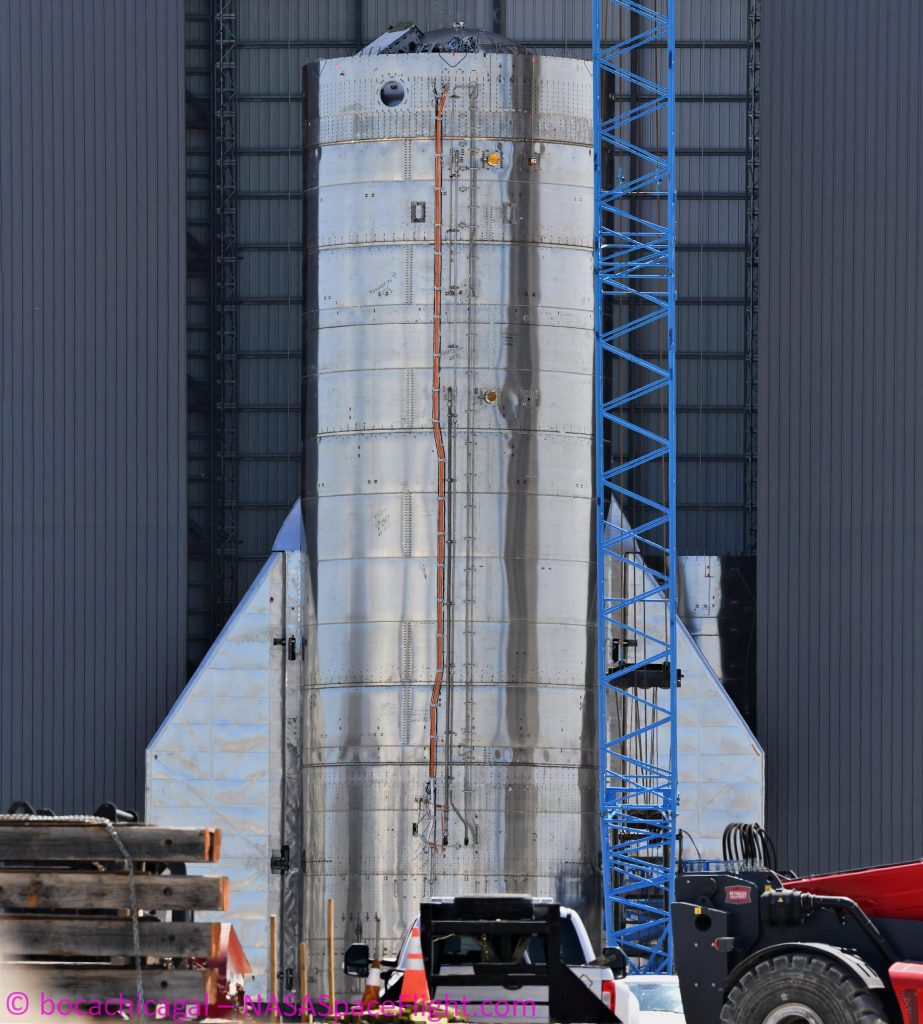

News
SpaceX Starship pop test opens the door for 60,000 foot hop [update]
SpaceX has successfully destroyed a Starship ‘test tank’ for the fourth time, opening the door for the first high-altitude prototype to roll to the launch pad as soon as tomorrow.
The culmination of three nights and more than 20 hours of concerted effort, SpaceX was finally able to fill Starship test tank SN7.1 with several hundred tons of liquid nitrogen before dawn on September 23rd. With just an hour left in the day’s test window, SpaceX closed the tank’s vents, allowing its cryogenic contents to boil into gas and expand with no outlet. At 4:57 am CDT, SN7.1 burst, bringing its lengthy test campaign to a decisive end.
A handful of hours later, new road closure notices revealed SpaceX’s plan to roll Starship SN8 – the first full-size prototype and first ship meant for high-altitude testing – from its Boca Chica factory to the launch site.
Update: All road closures planned for Starship SN8’s roll to the launch pad (Sept 24) and first test campaign (Sept 27-29) have been canceled. Stay tuned for updates on the high-altitude prototype’s test schedule.
Short of new information from SpaceX or CEO Elon Musk, little is known about the results of SN7.1’s lengthy test campaign, but the fact that it survived two nights of nondestructive testing – including the use of hydraulic rams to simulate Raptor thrust – effectively clears Starship SN8 for suborbital testing. Based on a speculative, amateur analysis of the aftermath of SN7.1’s burst test, it can also be tentatively concluded that the tank failed almost exactly where one would expect it to: the in-situ weld attaching the upper tank dome to SN7.1’s steel ring hull.
SN7.1’s forward dome appears to have cleanly sheared off around much of its circumferential weld joint – exactly what one would theoretically expect from a good, uniform weld. Assuming that SN7.1 reached pressures well above 8.5 bar (~125 psi) before it burst, the tank’s final test can likely be deemed a success.

The very same day SpaceX kicked off what would become Starship SN7.1’s last burst test attempt, teams worked to install functional flaps on a full-scale Starship prototype (SN8) for the first time ever. Effectively answering the question of whether SpaceX would fully outfit the ship with a nosecone and flaps before its first acceptance tests, SN7.1’s successful pop was followed by road closure notices for SN8’s transport to the launch pad around dawn on September 24th and cryptic “SN8 Testing” as early as September 27th.
As of September 23rd, SN8’s twin aft flaps – large aerodynamic control surfaces meant to stabilize free-falling Starships – have been fully installed alongside ‘aerocovers’ that will protect each flap’s control mechanisms. The only hardware Starship SN8 is missing is a ~20m (~60 ft) tall nosecone, two smaller forward flaps, and the plumbing needed to access a smaller liquid oxygen “header” tank located in the tip of said nose.
At the moment, SpaceX has installed one Starship nosecone prototype atop five unpressurized rings – creating a full nosecone stack. That particular prototype has no liquid oxygen header tank, however, meaning that SpaceX would likely need at least a day or two to weld one of the noses with a header tank atop one of several finished five-ring sections. In other words, to transport SN8 to the pad tomorrow, there’s almost no chance that SpaceX will have time to finish and install a proper nosecone on the prototype, meaning that the company has chosen to test the Starship before that milestone.


Doing so should reduce any inconvenience caused by vehicle failure in the event that Starship SN8’s acceptance test campaign doesn’t go as planned. In hindsight, the inclusion of Starship SN8’s aft flaps and aerocovers during the ship’s first major tests was likely a necessity, given that almost half of each flap and its support structure is installed directly to the skin of its liquid oxygen tank. Theoretically, when chilled to the temperature of liquid nitrogen or oxygen, the diameter of the stainless steel rings Starship SN8 is built out of could shrink by as much as 0.3% (~20 mm or ~0.8 in).
Only half of Starship SN8’s aft flaps will be directly subject to that tank contraction, resulting in a relatively complex environment for such a large, high-stress mechanical system. As such, testing flap actuation under cryogenic loads is likely a critical part of SN8’s cryogenic proof test, otherwise meant to demonstrate the structural integrity and functionality of Starship’s propellant tanks. If SN8 rolls to SpaceX’s launch facilities on schedule, the Starship’s first cryogenic proof test could begin as early as 9pm CDT (UTC-5) on Sunday, September 27th.
Check out Teslarati’s Marketplace! We offer Tesla accessories, including for the Tesla Cybertruck and Tesla Model 3.
News
Tesla cleared in Canada EV rebate investigation
Tesla has been cleared in an investigation into the company’s staggering number of EV rebate claims in Canada in January.

Canadian officials have cleared Tesla following an investigation into a large number of claims submitted to the country’s electric vehicle (EV) rebates earlier this year.
Transport Canada has ruled that there was no evidence of fraud after Tesla submitted 8,653 EV rebate claims for the country’s Incentives for Zero-Emission Vehicles (iZEV) program, as detailed in a report on Friday from The Globe and Mail. Despite the huge number of claims, Canadian authorities have found that the figure represented vehicles that had been delivered prior to the submission deadline for the program.
According to Transport Minister Chrystia Freeland, the claims “were determined to legitimately represent cars sold before January 12,” which was the final day for OEMs to submit these claims before the government suspended the program.
Upon initial reporting of the Tesla claims submitted in January, it was estimated that they were valued at around $43 million. In March, Freeland and Transport Canada opened the investigation into Tesla, noting that they would be freezing the rebate payments until the claims were found to be valid.
READ MORE ON ELECTRIC VEHICLES: EVs getting cleaner more quickly than expected in Europe: study
Huw Williams, Canadian Automobile Dealers Association Public Affairs Director, accepted the results of the investigation, while also questioning how Tesla knew to submit the claims that weekend, just before the program ran out.
“I think there’s a larger question as to how Tesla knew to run those through on that weekend,” Williams said. “It doesn’t appear to me that we have an investigation into any communication between Transport Canada and Tesla, between officials who may have shared information inappropriately.”
Tesla sales have been down in Canada for the first half of this year, amidst turmoil between the country and the Trump administration’s tariffs. Although Elon Musk has since stepped back from his role with the administration, a number of companies and officials in Canada were calling for a boycott of Tesla’s vehicles earlier this year, due in part to his association with Trump.
News
Tesla Semis to get 18 new Megachargers at this PepsiCo plant
PepsiCo is set to add more Tesla Semi Megachargers, this time at a facility in North Carolina.

Tesla partner PepsiCo is set to build new Semi charging stations at one of its manufacturing sites, as revealed in new permitting plans shared this week.
On Friday, Tesla charging station scout MarcoRP shared plans on X for 18 Semi Megacharging stalls at PepsiCo’s facility in Charlotte, North Carolina, coming as the latest update plans for the company’s increasingly electrified fleet. The stalls are set to be built side by side, along with three Tesla Megapack grid-scale battery systems.
The plans also note the faster charging speeds for the chargers, which can charge the Class 8 Semi at speeds of up to 1MW. Tesla says that the speed can charge the Semi back to roughly 70 percent in around 30 minutes.
You can see the site plans for the PepsiCo North Carolina Megacharger below.

Credit: PepsiCo (via MarcoRPi1 on X)

Credit: PepsiCo (via MarcoRPi1 on X)
READ MORE ON THE TESLA SEMI: Tesla to build Semi Megacharger station in Southern California
PepsiCo’s Tesla Semi fleet, other Megachargers, and initial tests and deliveries
PepsiCo was the first external customer to take delivery of Tesla’s Semis back in 2023, starting with just an initial order of 15. Since then, the company has continued to expand the fleet, recently taking delivery of an additional 50 units in California. The PepsiCo fleet was up to around 86 units as of last year, according to statements from Semi Senior Manager Dan Priestley.
Additionally, the company has similar Megachargers at its facilities in Modesto, Sacramento, and Fresno, California, and Tesla also submitted plans for approval to build 12 new Megacharging stalls in Los Angeles County.
Over the past couple of years, Tesla has also been delivering the electric Class 8 units to a number of other companies for pilot programs, and Priestley shared some results from PepsiCo’s initial Semi tests last year. Notably, the executive spoke with a handful of PepsiCo workers who said they really liked the Semi and wouldn’t plan on going back to diesel trucks.
The company is also nearing completion of a higher-volume Semi plant at its Gigafactory in Nevada, which is expected to eventually have an annual production capacity of 50,000 Semi units.
Tesla executive teases plan to further electrify supply chain
News
Tesla sales soar in Norway with new Model Y leading the charge
Tesla recorded a 54% year-over-year jump in new vehicle registrations in June.

Tesla is seeing strong momentum in Norway, with sales of the new Model Y helping the company maintain dominance in one of the world’s most electric vehicle-friendly markets.
Model Y upgrades and consumer preferences
According to the Norwegian Road Federation (OFV), Tesla recorded a 54% year-over-year jump in new vehicle registrations in June. The Model Y led the charge, posting a 115% increase compared to the same period last year. Tesla Norway’s growth was even more notable in May, with sales surging a whopping 213%, as noted in a CNBC report.
Christina Bu, secretary general of the Norwegian EV Association (NEVA), stated that Tesla’s strong market performance was partly due to the updated Model Y, which is really just a good car, period.
“I think it just has to do with the fact that they deliver a car which has quite a lot of value for money and is what Norwegians need. What Norwegians need, a large luggage space, all wheel drive, and a tow hitch, high ground clearance as well. In addition, quite good digital solutions which people have gotten used to, and also a charging network,” she said.
Tesla in Europe
Tesla’s success in Norway is supported by long-standing government incentives for EV adoption, including exemptions from VAT, road toll discounts, and access to bus lanes. Public and home charging infrastructure is also widely available, making the EV ownership experience in the country very convenient.
Tesla’s performance in Europe is still a mixed bag, with markets like Germany and France still seeing declines in recent months. In areas such as Norway, Spain, and Portugal, however, Tesla’s new car registrations are rising. Spain’s sales rose 61% and Portugal’s sales rose 7% last month. This suggests that regional demand may be stabilizing or rebounding in pockets of Europe.
-

 Elon Musk2 weeks ago
Elon Musk2 weeks agoTesla investors will be shocked by Jim Cramer’s latest assessment
-

 Elon Musk2 days ago
Elon Musk2 days agoxAI launches Grok 4 with new $300/month SuperGrok Heavy subscription
-

 Elon Musk4 days ago
Elon Musk4 days agoElon Musk confirms Grok 4 launch on July 9 with livestream event
-

 News1 week ago
News1 week agoTesla Model 3 ranks as the safest new car in Europe for 2025, per Euro NCAP tests
-

 Elon Musk2 weeks ago
Elon Musk2 weeks agoA Tesla just delivered itself to a customer autonomously, Elon Musk confirms
-

 Elon Musk1 week ago
Elon Musk1 week agoxAI’s Memphis data center receives air permit despite community criticism
-

 News2 weeks ago
News2 weeks agoXiaomi CEO congratulates Tesla on first FSD delivery: “We have to continue learning!”
-

 Investor's Corner2 weeks ago
Investor's Corner2 weeks agoTesla gets $475 price target from Benchmark amid initial Robotaxi rollout

















